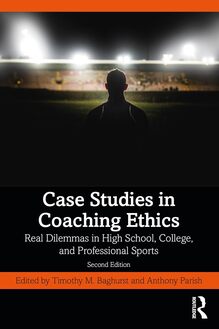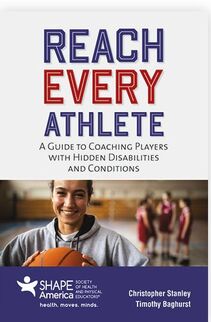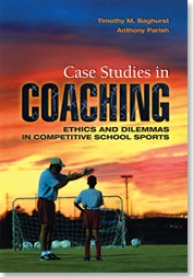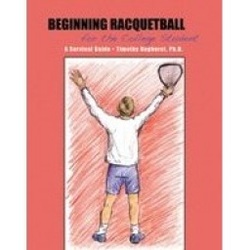Books

Reach Every Athlete: A Guide to Coaching Athletes with Hidden Disabilities and Conditions - Coaching is perhaps one of the hardest professions in society and taking the time for personal growth when so many demand your time and energy is challenging. This insightful book is your daily companion for growth and inspiration, offering 90 thought-provoking practical reflections, strategies, and stories from coaches and leaders that will question your why, the decisions you make, and provide practical suggestions to become better at your craft.
Whether you're a seasoned coach or just starting, this book provides daily nuggets of wisdom and motivation from those in the trenches that will hone your skills, help you better connect with your athletes, and foster a winning mindset.
Inside this book, you'll discover:
Whether you're a seasoned coach or just starting, this book provides daily nuggets of wisdom and motivation from those in the trenches that will hone your skills, help you better connect with your athletes, and foster a winning mindset.
Inside this book, you'll discover:
- Daily Wisdom: Dive into one meaningful thought per day, keeping you engaged and focused on your growth.
- Practical Tips: Implement actionable tips and techniques to improve your coaching approach.
- Inspiring Stories: Learn from the experiences of other coaches and leaders and how they overcame challenges.

Case Studies in Coaching - Coaches are placed in a myriad of ethical decision-making situations. Making decisions such as playing time, boosters, parents, social media, power differentials, scholarships, and relationships are just a few examples of what a coach may need to navigate. While many day-to-day situations are easily resolved, some are not. Therefore, how and by what process should a coach make these decisions? This book presents a variety of cases based on true stories that present some of the ethical decisions coaches must make across high school, collegiate, and professional sports.
Using a sequential system of less to more complicated, 40 case studies are presented across the sports spectrum that coaches have experienced. This is a key component of the book. Although names and situations have been changed, these cases have happened and provide real applicability to coaches. In addition, each case may contain multiple situations perhaps with no "right" answer that test a coach’s value system and ability to prioritize actions. Questions are provided at the end of each case that allow for reflection.
Using a sequential system of less to more complicated, 40 case studies are presented across the sports spectrum that coaches have experienced. This is a key component of the book. Although names and situations have been changed, these cases have happened and provide real applicability to coaches. In addition, each case may contain multiple situations perhaps with no "right" answer that test a coach’s value system and ability to prioritize actions. Questions are provided at the end of each case that allow for reflection.

Reach Every Athlete: A Guide to Coaching Athletes with Hidden Disabilities and Conditions was published in partnership with SHAPE America, this book guides coaches in working with athletes with disabilities that are not apparent based on physical features and athletic capabilities. Referred to as hidden disabilities or conditions (HDCs), there are athletes with a Specific Learning Disability (e.g. dyslexia), Autism Spectrum Disorder, and Attention Deficit and Hyperactivity Disorder (ADHD), as well sensory and physical impairments that may not be obvious, yet still impact performance.
Reach Every Athlete is ideal for coaches at all levels who may knowingly, or unknowingly, have an athlete on their team with an HDC. It helps clarify the core symptoms and impact, as well as provides coaching tips and best practices. This guide is also useful to others invested in maximizing the sport experience for athletes, including parents and caregivers, athletic administrators, coach educators, and sport psychology consultants.
Reach Every Athlete is ideal for coaches at all levels who may knowingly, or unknowingly, have an athlete on their team with an HDC. It helps clarify the core symptoms and impact, as well as provides coaching tips and best practices. This guide is also useful to others invested in maximizing the sport experience for athletes, including parents and caregivers, athletic administrators, coach educators, and sport psychology consultants.

Coaching for Sports Performance provides a practical overview of the many disciplines necessary to be an effective coach. Using experts from across the sports science fields, this book teaches readers the core concepts in a practical, easy to understand style, separated into four sections.
Part I explains the fundamentals of effective coaching including the development of coaching philosophies, best practices for coaching effectively, how athletic technique matures, and what coaches can and cannot do in specific health-related situations. Part II provides practical ways to improve athletic performance where readers learn the fundamentals of biomechanics and how to use technology to analyze performance, the physiological functions and adaptations to exercise, how the body can be physically trained and properly fueled, and mental strategies to optimize athletic outcomes. Part III introduces the business side of coaching, the important responsibilities involved in sport management, and practical methods for marketing as well as working with the media. Last, Part IV offers specific strategies for coaching across age and skill levels.
Chapters are split into youth and high school, collegiate, and professional athletes, and the nuances of coaching each level are explained. Being called "Coach" is an honor, but with this title comes the responsibility of being professional, knowledgeable, and effective.
Coaching for Sports Performance provides the platform for becoming a successful coach and assisting athletes in achieving their potential. Coaching for Sports Performance provides a practical overview of the many disciplines necessary to be an effective coach.
Part I explains the fundamentals of effective coaching including the development of coaching philosophies, best practices for coaching effectively, how athletic technique matures, and what coaches can and cannot do in specific health-related situations. Part II provides practical ways to improve athletic performance where readers learn the fundamentals of biomechanics and how to use technology to analyze performance, the physiological functions and adaptations to exercise, how the body can be physically trained and properly fueled, and mental strategies to optimize athletic outcomes. Part III introduces the business side of coaching, the important responsibilities involved in sport management, and practical methods for marketing as well as working with the media. Last, Part IV offers specific strategies for coaching across age and skill levels.
Chapters are split into youth and high school, collegiate, and professional athletes, and the nuances of coaching each level are explained. Being called "Coach" is an honor, but with this title comes the responsibility of being professional, knowledgeable, and effective.
Coaching for Sports Performance provides the platform for becoming a successful coach and assisting athletes in achieving their potential. Coaching for Sports Performance provides a practical overview of the many disciplines necessary to be an effective coach.

Writing and Publishing Research in Kinesiology, Health, and Sports Science is published by Routledge. Drawing on real-world experience and presented in an informal and accessible manner, Writing and Publishing Research in Kinesiology, Health, and Sport Science provides upper-level students and early-career academics with an essential resource to aid in disseminating research and publishing their first papers.
Logically structured to take researchers through each step of the publishing process, the book offers subject-specific advice on developing every aspect of theoretical, applied, or position papers, including:
• the title, abstract and keywords
• method, results, and discussion sections
• referencing
• finding the right journal and submitting a paper
• revising content in light of peer review
• presenting papers.
This is important and accessible reading for any researchers seeking advice on publishing their work in fields including but not limited to kinesiology, health, exercise science, physical education, or recreation.
Logically structured to take researchers through each step of the publishing process, the book offers subject-specific advice on developing every aspect of theoretical, applied, or position papers, including:
• the title, abstract and keywords
• method, results, and discussion sections
• referencing
• finding the right journal and submitting a paper
• revising content in light of peer review
• presenting papers.
This is important and accessible reading for any researchers seeking advice on publishing their work in fields including but not limited to kinesiology, health, exercise science, physical education, or recreation.

Sports Nutrition: A Guide for Youth Sport Coaches is published by Nova. In the United States alone, over 60 million youth participate in organized sports. This book is designed to assist coaches of these youth by providing a fundamental understanding of sports nutrition and how to correctly fuel athletes for athletic performance. Chapters include the basics of sports nutrition, fuel for the body, timing and type of meals and snacks, fluids and hydration, dietary supplements, eating disorders, and body image, and special considerations for athletes such as those who are vegetarian, diabetic, or have a food allergy. The final chapter provides practical suggestions for parents to appreciate the importance of sports nutrition for their athlete. A greater knowledge and application of sports nutrition will assist in optimal sports performances as well as improved overall health and well-being for the athlete. (Imprint: Novinka)

Case Studies in Coaching: Ethics and Dilemmas in Competitive School Sports is published by Holcomb Hathaway. The nearly two dozen case studies in this realistic, timely book will help future and current coaches of youth sports develop successful strategies to avoid or overcome obstacles and become more aware of the need to remain professional and consider the implications of their actions. Based on real-life situations, it considers ethical and practical dilemmas from sports in locations across the country.
These compelling case studies illustrate everyday scenarios—such as teaching style conflicts, scheduling issues, cheating, confidentiality decisions, and working with over-involved parents—that occur in school coaching and athletics. The cases and the thought-provoking discussion questions that follow allow readers to work through the types of dilemmas they will face in their coaching careers and then carefully formulate their responses and decisions. A resource list for each case allows readers to further explore the issues and develop their personal responses to each situation. An accompanying instructor's manual, available upon adoption, includes possible responses to all discussion questions.
These compelling case studies illustrate everyday scenarios—such as teaching style conflicts, scheduling issues, cheating, confidentiality decisions, and working with over-involved parents—that occur in school coaching and athletics. The cases and the thought-provoking discussion questions that follow allow readers to work through the types of dilemmas they will face in their coaching careers and then carefully formulate their responses and decisions. A resource list for each case allows readers to further explore the issues and develop their personal responses to each situation. An accompanying instructor's manual, available upon adoption, includes possible responses to all discussion questions.

Beginning Racquetball for the College Student: A Survival Guide was published in 2008 by Kendall Hunt (then bought out by Taylor & Francis). It is written for beginning racquetball classes and players and is an easy-to-read manual on the basics of the game. It is designed to provide the beginning student with the bare necessities about game rules, competent play, and basic strategies of racquetball. Detailed illustrations help students visualize grips, ball placement, and player movement on the court. Instructions directed at beginning racquetball teachers help customize drills and games to class size and student ability. The book covers equipment and safety; scoring; grips; forehand and backhand swings; offensive and defensive strokes; serves and returns; strategies; terminology; and ways to gain a competitive edge. There are also sections on drills and competitive play for students who want to get serious about the sport, including information on racquetball associations and official rules of play. Features An easy-to-read style helps students understand the elements of the game. Detailed illustrations help students visualize grips, ball placement, and player movement on the court. Instructions directed at racquetball teachers aid in classroom drills and games. Chapters on weight training and nutrition give students a competitive edge.
